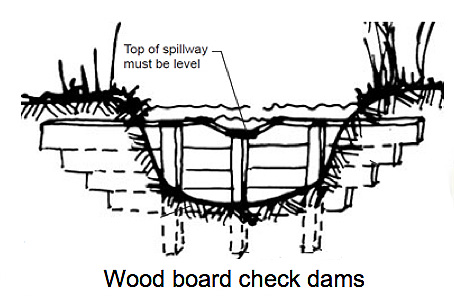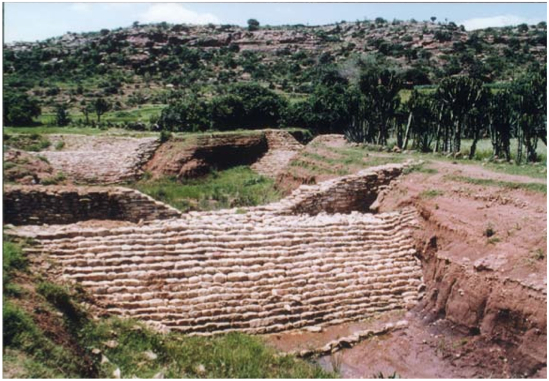Water Portal / Rainwater Harvesting / Groundwater recharge / Check dams (gully plugs)
A check dam is a small, temporary or permanent dam constructed across a drainage ditch, gully, swale, or channel to lower the speed of concentrated flows (like an overflow weir) for a certain design range of storm events. They may be more categorized as a type of floodwater rather than a runoff harvesting technique. A check dam can be built from logs of wood, stone, pea gravel-filled sandbags or bricks and cement. They have been used widely in Kenya and India. These dams can also be made as leaky dams. Dams that have been built in riverbeds with no coarse sand transport (Sand dams) may end up being used in this way. These structures are relatively cheap and can last about 2-5 years.
Suitable conditions
| ||||||
|
- Locate in natural runoff areas
- Soil in vicinity needs to have sufficient infiltration capacity.
| Advantages | Disadvantages/limitations |
|---|---|
| - Water speed is slowed, which reduces erosion and prevents unwanted gully formation during a flood - No trench design required, just uses existing gully drainage pattern |
- If designed incorrectly, may block fish passage - They can silt up and will need maintenance |
Construction, operations and maintenance


Drawing: Water Conservation Technical Briefs. SAI.
The sides of the check dam must be higher than the centre so that water is always directed over the centre of the dam (this avoids the dam being outflanked by the flow).
The dams can be made of temporary or permanent materials in natural gullies in the land surface. Materials used are concrete, earth, vegetation, stone and brushwood. Where earth is used, erosion or destruction of the structure needs to be avoided – to do this, a concrete spillway is often constructed. As they use the existing drainage system, no design of trench is needed (as with contour trenches).
Do not construct check dams in watercourses or permanently flowing streams without specific design (because of possible restrictions to fish passage).
Water extraction
- Water that infiltrates is used as soil moisture for crops cultivated after a rainfall event.
- Water can be used directly for pumped irrigation.
- Water can be taken from shallow wells and boreholes in the immediate area.
Maintenance
Check dams should be inspected regularly for sediment accumulation after each significant rainfall. Sediment should be removed when it reaches one-half of the original height or before. Check to ensure that the flow is over the centre of the dam and not either under or around the dam. Check that there is no erosion at the outfall.
Costs
The cost in India is reported to be between US$200-400 for temporary dams (made from brush wood, rocks, soil) and US$1,000- 3,000 for permanent dams (made from stones, bricks, cement), depending on the length and height. Variation depends on materials used and size of gully.
Field experiences
In Ethiopia, unclarity over land tenure led to progressive abandonment of cropping in gullies. See: Falkenmark, M.; Fox, P.; Persson, G.; Rockström, J. (2001) Water harvesting for upgrading of rainfed agriculture. Problem analysis and research needs. Stockholm International Water Institute.
Reference manuals, videos, and links
- Technologies for water harvesting and soil moisture conservation in small watersheds for small-scale irrigation, by R.K. Sivanappan.
Acknowledgements
- CARE Nederland, Desk Study Resilient WASH systems in drought prone areas. October 2010.
- Rufino, L., Water Conservation Technical Briefs: TB 2 – Rainwater Harvesting and Artificial Recharge to Groundwater. Sustainable Agriculture Initiative (SAI). August 2009.

